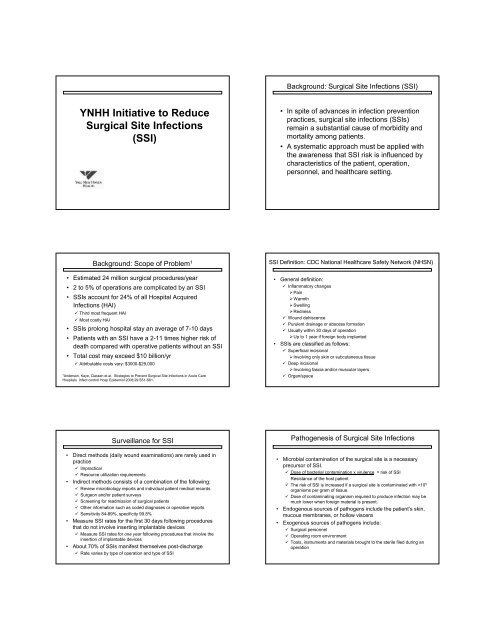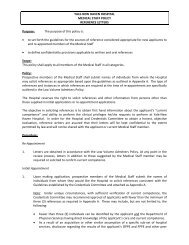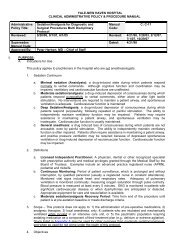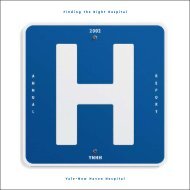Medical Staff Education Reading Materials - Yale-New Haven Hospital
Medical Staff Education Reading Materials - Yale-New Haven Hospital
Medical Staff Education Reading Materials - Yale-New Haven Hospital
Create successful ePaper yourself
Turn your PDF publications into a flip-book with our unique Google optimized e-Paper software.
YNHH Initiative to Reduce<br />
Surgical Site Infections<br />
(SSI)<br />
Background: Scope of Problem 1<br />
• Estimated 24 million surgical procedures/year<br />
• 2 to 5% of operations are complicated by an SSI<br />
• SSIs account for 24% of all <strong>Hospital</strong> Acquired<br />
Infections (HAI)<br />
Third most frequent HAI<br />
Most costly HAI<br />
• SSIs prolong hospital stay an average of 7-10 days<br />
• Patients with an SSI have a 2-11 times higher risk of<br />
death compared with operative patients without an SSI<br />
• Total cost may exceed $10 billion/yr<br />
Attributable costs vary: $3000-$29,000<br />
1 Anderson, Kaye, Classen et al. Strategies to Prevent Surgical Site Infections in Acute Care<br />
<strong>Hospital</strong>s Infect control Hosp Epidemiol 2008;29:S51-S61.<br />
Surveillance for SSI<br />
• Direct methods (daily wound examinations) are rarely used in<br />
practice<br />
Impractical<br />
Resource utilization requirements<br />
• Indirect methods consists of a combination of the following:<br />
Review microbiology reports and individual patient medical records<br />
Surgeon and/or patient surveys<br />
Screening for readmission of surgical patients<br />
Other information such as coded diagnoses or operative reports<br />
Sensitivity 84-89%, specificity 99.8%<br />
• Measure SSI rates for the first 30 days following procedures<br />
that do not involve inserting implantable devices<br />
Measure SSI rates for one year following procedures that involve the<br />
insertion of implantable devices<br />
• About 70% of SSIs manifest themselves post-discharge<br />
Rate varies by type of operation and type of SSI<br />
Background: Surgical Site Infections (SSI)<br />
• In spite of advances in infection prevention<br />
practices, surgical site infections (SSIs)<br />
remain a substantial cause of morbidity and<br />
mortality among patients.<br />
• A systematic approach must be applied with<br />
the awareness that SSI risk is influenced by<br />
characteristics of the patient, operation,<br />
personnel, and healthcare setting.<br />
SSI Definition: CDC National Healthcare Safety Network (NHSN)<br />
• General definition:<br />
Inflammatory changes<br />
Pain<br />
Warmth<br />
Swelling<br />
Redness<br />
Wound dehiscence<br />
Purulent drainage or abscess formation<br />
Usually within 30 days of operation<br />
Up to 1 year if foreign body implanted<br />
• SSIs are classified as follows:<br />
Superficial incisional<br />
Involving only skin or subcutaneous tissue<br />
Deep incisional<br />
Involving fascia and/or muscular layers<br />
Organ/space<br />
Pathogenesis of Surgical Site Infections<br />
• Microbial contamination of the surgical site is a necessary<br />
precursor of SSI.<br />
Dose of bacterial contamination x virulence = risk of SSI<br />
Resistance of the host patient<br />
The risk of SSI is increased if a surgical site is contaminated with >10 5<br />
organisms per gram of tissue.<br />
Dose of contaminating organism required to produce infection may be<br />
much lower when foreign material is present.<br />
• Endogenous sources of pathogens include the patient’s skin,<br />
mucous membranes, or hollow viscera<br />
• Exogenous sources of pathogens include:<br />
Surgical personnel<br />
Operating room environment<br />
Tools, instruments and materials brought to the sterile filed during an<br />
operation






![Annual Report Donor Listings [pdf] - Yale-New Haven Hospital](https://img.yumpu.com/49673575/1/190x245/annual-report-donor-listings-pdf-yale-new-haven-hospital.jpg?quality=85)










